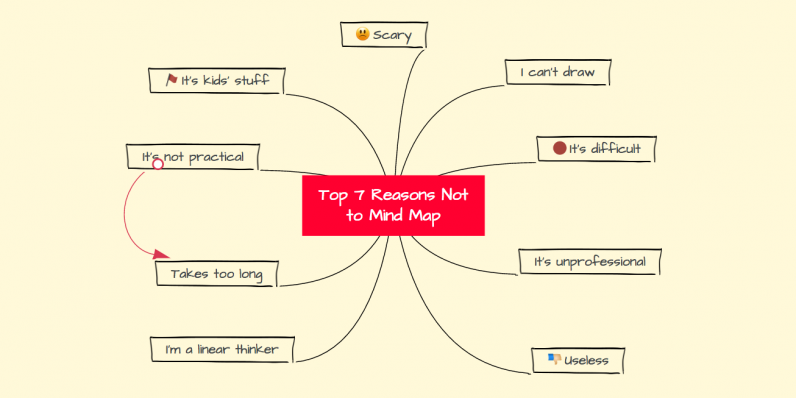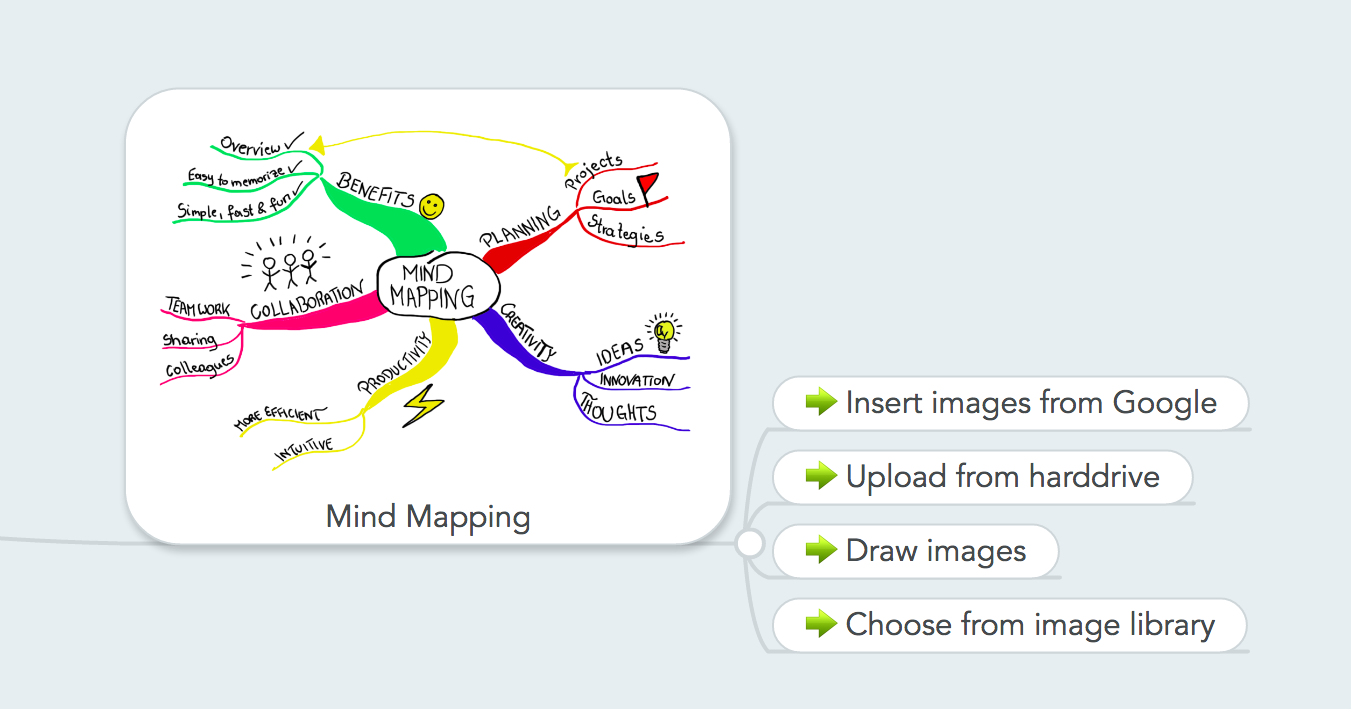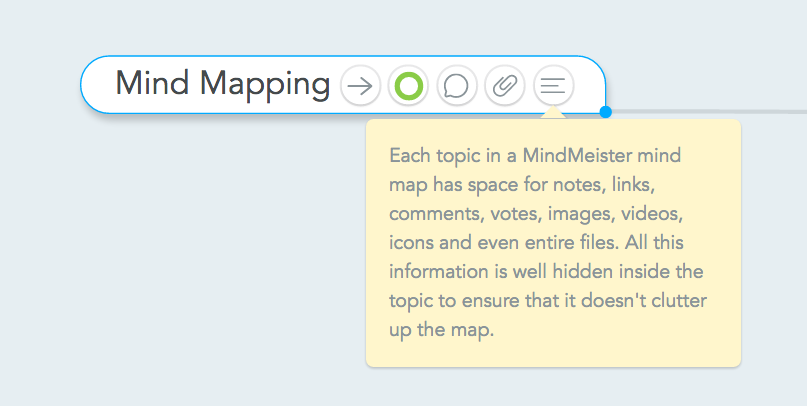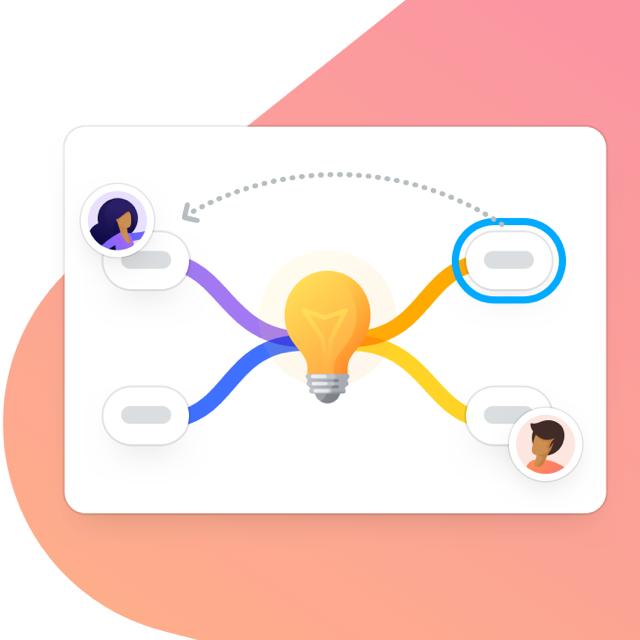Over the years we’ve talked to quite a large number of people about mind mapping, and based on what they told us, we’ve put together a list of the top 7 reasons not to mind map. If you’re thinking about giving mind mapping a try, be sure to take a look at this list first:

1. “I can’t draw.”
While some people are surely more talented than others, saying that you can’t draw is – in most cases – simply not true. If you can hold a pen and use it to write, you can also use it to draw. Your drawings might not look as good as you’d like them to, but the point of drawing in a mind map is not to create an art piece for a gallery opening. The point is to personalize your map with images and recognizable symbols and thus make it easier for your brain to remember the map’s content.
If you still can’t get used to the drawing part, there’s always digital mind mapping, where you can choose your icons and images from a library.
2. “This is kids’ stuff.” / “Mind maps are unprofessional.”
The statement “This is kids’ stuff” is partially true, seeing as mind maps are indeed a technique even preschoolers can use. But to conclude that they are not suitable for grown-ups or that they are unprofessional would be a mistake. Mind maps are being used by a steadily growing number of businesses and entrepreneurs who appreciate the value of this powerful presentation, collaboration and project planning tool. Digital and online mind mapping solutions usually offer a user interface perfectly suitable for businesses and their maps look as professional as it gets.
3. “Mind maps can hold very little information.”
While this is partly true for paper mind maps, which are usually limited to the space of an A4 sheet, digital and online mind maps are a completely different story. Since you can add links, images, notes, comments and even upload entire files to each topic, digital maps can actually be used as data pools or knowledge maps, and hold a technically unlimited amount of information (depending on the software used and the way the information is stored). With the right system, even paper maps can hold huge amounts of information while still being clearer than linear notes. More about this under point 6.
4. “Mind mapping takes longer than regular note taking.”
A lot of people think that, because there is drawing involved in a mind map, they take more time to create than your standard linear notes. The truth is, you can spend hours perfecting your mind map to turn it into a piece of art, if that’s what you want to do. But in most cases, note taking with mind maps will actually help you save time. Instead of writing whole sentences and filling page after page in your notebook, a mind map forces you to consciously decide which information is important enough to become its own topic. Sticking to keywords and images eliminates all the unnecessary fluff and thus saves you valuable time, especially when you review your notes later on.
5. “I’m a linear thinker.”
Some people are so accustomed to processing information stored in a linear manner that they’ve really become quite good at it. But that doesn’t necessarily make them linear thinkers, at least not exclusively.
Even if you feel comfortable with your old thinking method, why wouldn’t you want to utilize other techniques that can improve your creativity, memory and problem solving abilities? Why would you limit yourself, when expanding your range of tools and techniques might give you a competitive advantage? Linear thinking, radiant thinking, visual, lateral or parallel thinking – why not try to combine them all to make use of your brain’s full potential?
6. “Mind maps aren’t practical.”
Many people who are used to storing their information in notebooks or Word documents think that mind maps just aren’t practical as an everyday solution. Most of the time, they are worried about 3 things:
1. Running out of space when dealing with big, complex topics
As mentioned earlier, digital maps can hold vast amounts of information. Even so, some topics are so large and complex that mind maps can become too cluttered, thus losing the great overview they usually provide. The solution to this problem is to create a network of mind maps that are linked with each other, as you can do with MindMeister and other mind mapping software.
Instead of trying to squeeze thousands of topics into map, simply create an index map with the main categories of your topic or project, and create a sub map for each of those categories. Each sub map can be filled with information, or link to even more sub maps. Using MindMeister, you can easily link your maps to jump back and forth between them.
2. Not being able to store their maps properly
You can store paper maps in a binder or folder, just like you would with any other piece of paper. Alternatively, you can scan them and put them into a digital filing system such as Evernote. Online mind mapping software lets you store all your mind maps in the cloud and access them from any computer as well as your mobile device. You can also create a practical folder structure to stay organized and retrieve your maps quickly when needed.
3. Not being able to share their maps with others
Well, you can share paper maps like you would share any other piece of paper, that is, make a paper copy or scan them in to share via email, for instance. The various mind mapping software solutions use different formats for their maps, but they usually offer import options for a number of formats other than their own. Online solutions such as MindMeister even allow you to share your maps with entire groups of users and collaborate with them in real-time.
7. “I’ve gone through my entire life without this. Why should I start now?”
Well, this is a really bad reason not to try something new. Here’s why we think you should:
- Mind maps are easy to create.
- They are a professional business tool.
- They can hold large amounts of information.
- They help you save time.
- They improve creativity, memory and problem solving abilities.
- They are extremely practical
😉
Can you think of another reason not to mind map? Let us know in the comments below so we can discuss your argument!




